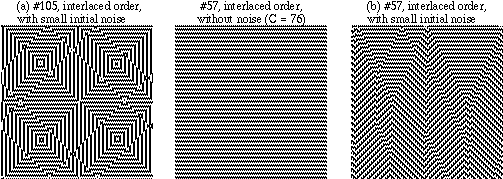
These differences are shown in Figure 17. Figure 17a and b show patterns generated by automata #105 and #37 (See also Figures 11 and 12). The initial state is almost black, but there are two white points. It is easy to see the two different effects caused both by the fluctuation on the order of computation and by the noise in the initial state. The former noise works near the left edge of the patterns and near the center (at cells 1 and 76). It is not easy to see the propagation of the latter noise in this figure. To clarify the non-local structure, the time-scale is reduced by half in Figures 17c and d. Figure 17c shows the pattern generated when there is no initial noise. Many domains with different textures, or locally repetitive structures, can be seen in this figure. No such phenomena occur, if the order of computation is alternate, i.e., even cells are computed first and then odd cells are computed. Although the long-scale pattern is periodical, the cycle is so long that it is not possible to show a whole cycle in the figure. Figure 17d shows a pattern with a small initial noise. The propagation of the noise can be tracked in this figure. They refract when they go into a different domain, and sometimes cause new waves. Detailed analysis of these phenomena is a future work.
Figure 17e shows a pattern generated by automaton #57 using a fixed random order. The initial state is uniformly white. This pattern is chaotic and completely different from that shown in Figure 17b. However, the characteristics of most other patterns are not destroyed by this computation order. An example, a pattern generated by automaton #146, is shown in Figure 17f. There are no significant differences between this and pattern D2. (Similar examples are here.)